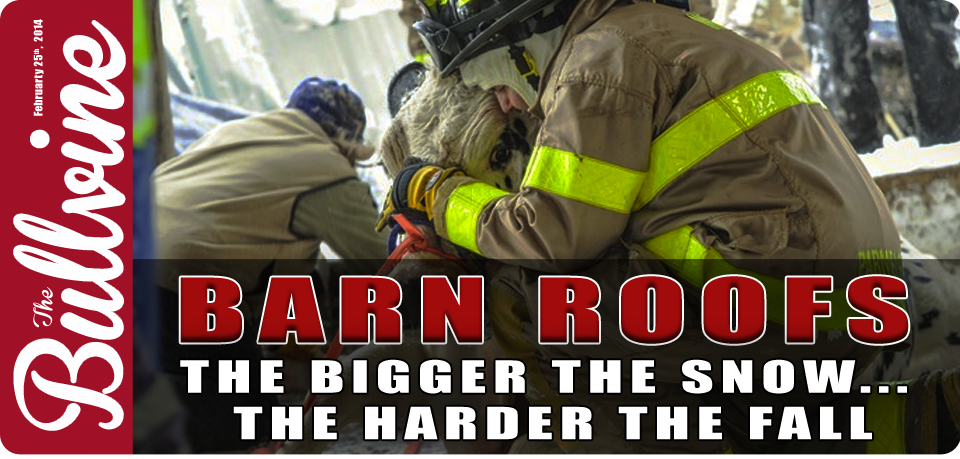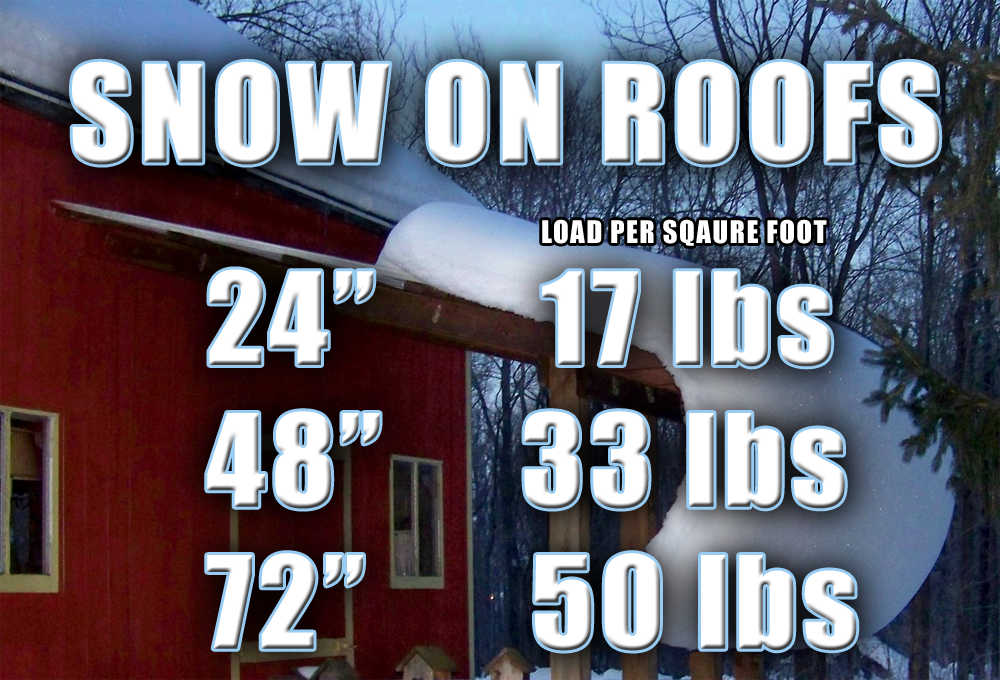Barns are collapsing like houses of cards when stressed by the triple threats of frozen snow load, wet snow load and water build up. Since early December more than a dozen barns have collapsed in central Alberta. All the way east to Maine and Massachusetts reports of collapsed roofs are resulting from record snowfalls.
You may feel secure because of your well-designed barn that has engineered support structures. But even these buildings can buckle under snow loads that exceed 4 to 6 feet. When researching what the “danger” level is for extended snow loads, we found a general guide for areas where typical snow loads are 20 pounds per square foot to be 4 feet of dry snow or 2 feet of wet heavy snow. These heavy loads are the usual cause of snow-related building collapses. This winter has had many episodes of extreme weather. One would think that the recent slight rise in temperature and change to rain and sleet has helped. However, now that extra rainwater has been soaked up by the snow. The end result is even more weight added to roofs. There is a tremendous difference between dry and wet snow. A cubic foot of dry snow weights 6 to 8 pounds. The same volume of ice weighs three times that amount.
Snow Blows Before a Fall
Checking structures after every snowfall is a must-do, every time priority. Conditions change quickly. It isn’t simply the snowfall that is to be blame. It’s continuing or shifting snow load. When heavy snow meets fierce winds even the best engineered buildings can collapse. An imbalance of drifting snow can cause one part of a roof to give way causing a domino effect that affects the rest of the structure. Other times, a wet snowfall which freezes the snow on the roof can mean that future snow is unable to slide off. According to the Massachusetts Emergency Management Agency (MEMA), in the first 48 hours after the Groundhog Day snowstorm, there were more than 80 collapses and building with structural weaknesses reported to MEMA.
12 Ways to Pinpoint Potential Problems
When you see any of the following problems, call your local building or fire official immediately.
- Sagging roofs
- Severe roof leaks
- Doors that pop open
- Cracks in walls or masonry
- Bends or ripples in supports
- Visible bowing of rafters
- Cracked or split wood members
- Sheared off screws from steel frames
- Creaking, cracking or popping sounds
- Doors or windows that stick or won’t open
- Bowed utility pipes or conduit at ceiling
- Sprinkler heads that have dropped down below ceiling tiles
Note:Metal structures unfortunately often don’t exhibit signs of stress before failure.
How Much Snow is Too Much?
Calculating the snow load on your barn takes more than an educated guess. The University of Wisconsin Cooperative Extension Service says that a ballpark estimate of snow load can be made with the following formula:
Calculated Roof Loading (lb/ft2) = Depth (ft) x Density (lb/ft2 /ft depth). The approximate density (lb/ft2 /ft depth) for light snow is 5-20, packed snow 20-40, packed snow with ice 40-58, and ice 58.
For example, a roof with 3 feet of light snow has an estimated roof load of 60 pounds per square foot (3 ft depth X 20 lb/ft2/ft depth density = 60 lb/ft2). You should know the roof weight limits for your barns and outbuildings, and rebuild or fortify them to withstand worst-case scenario snow loads and meet local building standards.
Consultation and Calculation
Consult your local permit issuing authority to find the recorded snow load (the maximum snow expected to fall) in your region.
Calculate your roof pitch: Divide the “rise” (vertical distance between the peak of the roof and the edge) by the “run” (distance from the peak of your roof to the edge) and convert the fraction to a ratio of 12. (For example, if the rise of your roof is 15 feet, the run is 36 feet, then the pitch = 15 feet / 36 feet = 5:12. Use a calculation like this one. Enter values of your roof and follow the instructions to get your roof snow load.
Long Term Improvements
If you are able to renovate or are building new buildings there are snow load factors to consider. Snow does not slide easily off flatter roofs with a pitch of 3/12 or less. In locating new buildings be aware that wind blowing around trees and building can cause mega drifting and uneven and shifting snow loads. Be aware that closely spaced buildings can be affected by snow and ice sliding off taller buildings. As well valleys or changing elevations in the roof can collect snow. The material used for roofing should shed snow and ice easily. Metal is better than shingles.
Be Safe NOT Sorry.
What should be done if your building exceeds the “safe” snow depths? The simple answer is to get it off as soon as possible. Generally, there is some time between a large snowfall event and possible structural failure. Some failures can be prevented with careful snow removal. Consider hiring a professional.
Safety First
There obviously is a human safety concern of falling off the roof when working on a snow covered and icy roof. Use extreme caution when working near overhead electrical power lines.
Use caution if standing on the roof. Make sure to wear a safety harness and use securing ropes or cables. Don’t add your weight or the weight of equipment to the roof. Always be aware that, if you use a ladder, ice tends to build up on both the rungs and your shoes. Wear headgear and goggles and non-slip footwear. Have someone outside to team with. As a precaution, if the situation seems tenuous, remove animals from the building.
Don`t Add to the Problem
Don’t use electric heating devices like heat guns to remove snow and ice. Don’t use open-flame devices to remove snow and ice. Trying to hose down the snow is a mistake as the added water seriously increases the weight pushing down on the already straining supports. Use a snow rake for pitched roofs and avoid chipping or picking away at ice as that may damage the roof and lead to leaks. Plastic shovels are better than metal ones (metal tools conduct electricity and damage roofs).
Just Enough. Not too much.
Start from the edge to the peak of the roof. Shave the snow down to 2-3 inches instead of scraping the roof clean; don’t damage the shingles. Remove snow in narrow strips to keep the load somewhat even. Remove large icicles carefully. Not all snow needs to be removed. A thin layer of snow can protect the roof from damage while snow is being removed.
Other Options
Until or unless you are already dealing with a collapsed roof, there are other last minute (and therefore less reliable) options depending on specific situations. Sometimes you may be able to warm the inside of the building enough to melt the ice layer and wait for the ice and snow to slide off. There are obvious dangers of fire when adding heat and also limitations to how much you can raise the temperature depending on building size and structure (no flat ceilings). Beware of large chunks of sliding ice and snow falling onto people, animals or equipment. Safety is always, always, always priority number ONE!
The Bullvine Bottom Line
Farmers need to keep a close watch on structures with heavy loads and be prepared to move livestock and equipment to safer quarters. A few minutes of consultation can give you reassurance during a heavy-snow winter. Check with your insurance agent to confirm that your property insurance covers roof or building failure due to snow load. Make sure the policy pays for actual replacement costs, so you’re not out in the cold if you have to rebuild. Verify that valuable equipment stored in a barn or outbuilding is covered under your policy.
Get original “Bullvine” content sent straight to your email inbox for free.



















Wow – coming from the southern hemisphere, this is an amazing read and it has great content and information. A story that could bear repeating in many publications. It may seem common sense, but I’m sure many people will take something out of it and hopefully save their barn one day. We may have snakes, but I sure as heck wouldn’t want to battle all that snow and ice knowing my herd was vulnerable underneath it. Wish we could send some of our heat over there….well done to The Bullvine for writing it.